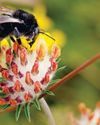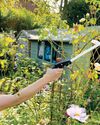
BIOLOGICAL pest control is a ‘bug eats bug’ approach that involves the use of natural enemies to help control pests on your plants. There are predators for almost all situations now, not just outside in the garden but also in enclosed places such as indoor rooms, conservatories, greenhouses and polythene-clad structures where edible plants may grow alongside ornamental and tender ones.
Selective organic control
This method of pest control is suitable for organic gardeners and anyone who is reluctant to use pesticides, especially indoors or on plants being grown for food. The predators or parasites are bred to be host-specific, so they will only prey on the insect pest you wish to control and are harmless to other wildlife and pets.
Management not elimination
Dealing with pests biologically is quite different from the traditional practice of aiming to wipe out the whole pest population with one or two applications of a chemical. Biological control is actually about pest management, rather than outright control, so the aim is to keep the pest population at a manageable level, rather than eliminating it altogether. If the pest population disappears completely, the control agent will die out, too, due either to a lack of food or a disrupted lifecycle. So, the aim is to have a balance at all times, with a low population of pests supporting a low population of control.
The two ways biological controls work
This story is from the June 19, 2021 edition of Amateur Gardening.
Start your 7-day Magzter GOLD free trial to access thousands of curated premium stories, and 8,500+ magazines and newspapers.
Already a subscriber ? Sign In
This story is from the June 19, 2021 edition of Amateur Gardening.
Start your 7-day Magzter GOLD free trial to access thousands of curated premium stories, and 8,500+ magazines and newspapers.
Already a subscriber? Sign In

To dig or not to dig?
Should we be carrying out a full dig on plots now? Bob considers the pros and cons of the 'autumn dig' debate

The box ball blues
As if his beleaguered box hadn't already taken a beating, Toby now has to deal with some hungry box caterpillars

Save your own seeds
Masterclass on: seed saving

Strange sightings
Three unusual insects turn up in Val's garden in one day

A bolt from the blue!
Cornflowers are perfect for garden and vase

Winter moth prevention
Ruth shows you how to avoid maggoty tree fruits

Create a winter container
There are as many options as in summer

Lightweight gardening tools
AS well as being good for our mental health, gardening is also great exercise.

Autumn price round-up
AG finds better bargains in lesser-known brands

Rudbeckias
Rudbeckias are ideal for sunny summer patios and borders, with some able to survive our coldest winters